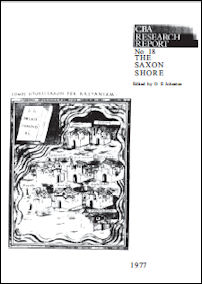CBA Research Reports
Council for British Archaeology, 2000. (updated 2020) https://doi.org/10.5284/1000332. How to cite using this DOI
Data copyright © Council for British Archaeology unless otherwise stated
This work is licensed under the ADS Terms of Use and Access.
Primary contact
Council for British Archaeology
92 Micklegate
York
YO1 6JX
UK
Tel: 01904 671417
Resource identifiers
- ADS Collection: 281
- DOI:https://doi.org/10.5284/1000332
- How to cite using this DOI
The Saxon shore
D E Johnston (editor)
CBA Research Report No 18 (1977)
Abstract

The preface to this volume of papers given at a conference in 1975 contains a critique by R M Reece of the way that historical and archaeological evidence are mixed together when they should be kept separate. Barry Cunliffe's paper (1-6) summarizing the problems calls for a much more rigorous approach to excavation, analysis and publication. M W C Hassall (7-10) discusses the historical background, principally the Notitia Dignitatum, and the problems of identifying units and forts on both sides of the Channel. J C Mann's contribution (11-15) is on the military organization of duces and comites in the 4th century, plus a note on the Reculver inscription. The Classis Britannica is treated by Henry Cleere (16-19) from its beginnings in AD 40 or 43, through its iron-producing activities in the Weald, to its disappearance from the record in mid-3rd century. There follow papers on the detailed archaeological evidence: Dover (Brian Philp), Brancaster (D A Edwards and C J S Green), Lympne (Barry Cunliffe), the Channel Isles (David Johnston), Boulogne and coastal defences in 4th-5th centuries (C Seillier), Alet (Loïc Langouët), Brest (René Sanquer) and Oudenburg (J Mertens). The interpretation of the term 'Saxon Shore' is discussed by Stephen Johnson (63-9), and the evidence for religious missions in the shore forts is Stuart Rigold's subject (70-75). The absence of informative inscriptions from the shore forts is taken by J J Wilkes (76-80) as significant and possibly providing a date of AD 260-96 for the system.
Contents
- Title pages
- List of Contributors (p iii)
- Editor's Foreword by D E Johnston (p v)
- The Saxon Shore - some problems and misconceptions by Barry Cunliffe (p 1)
- The historical background and military units of the Saxon Shore by M W C Hassall (p 7)
- Duces and comites in the 4th century by J C Mann (p 11)
- The Reculver inscription - a note by J C Mann (p 15)
- The Classis Britannica by Henry Cleere (p 16)
- The British evidence
- Dover by Brian Philp (p 20)
- The Saxon Shore fort and settlement at Brancaster, Norfolk by Derek A Edwards and Christopher J S Green (p 21)
- Lympne - a preparatory comment by Barry Cunliffe (p 29)
- The Gallic evidence
- The Channel Islands by David E Johnston (p 31)
- Boulogne and coastal defences in the 4th and 5th centuries by C L Seillier (p 35)
- The 4th century Gallo-Roman site at Alet (Saint-Malo) by Loïc Langouët (p 38)
- The castellum at Brest (Finistère) by René Sanquer (p 45)
- Oudenburg and the northern section of the continental Litus Saxonicum by J Mertens (p 51)
- Late Roman defences and the Limes by S Johnson (p 63)
- Litus Romanum - the Shore forts as mission stations by S E Rigold (p 70)
- The Saxon Shore - British anonymity in the Roman Empire by J J Wilkes (p 76)
- Bibliography (p 81)
- Index (p 89)
Download report
| The Saxon shore (CBA Research Report 18) | 7 Mb |







